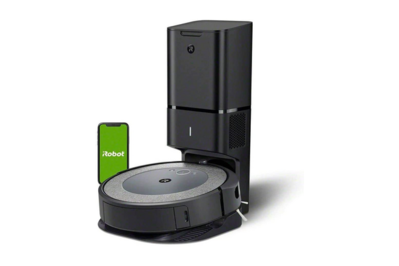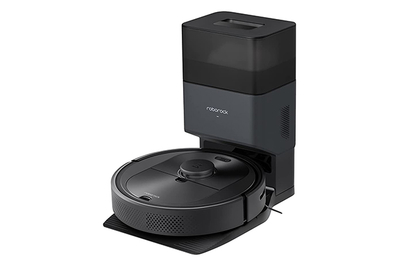A robot vacuum can make daily or weekly cleanings actually happen, without your having to do anything. (And if you count pushing a button as work, you and I are soulmates!) A self-emptying robot vacuum makes using a robot vacuum even more convenient. No, it doesn’t climb up into your trash can and empty itself. Rather, the robot comes with a large charging station that sucks the debris out each time the robot docks. It all makes for a pretty awesome process—and not just because it makes a whoosh sound like jets are firing up in your living room. All you have to do is remember to empty the dock every month or so, or whenever it gets full.
The iRobot Roomba i3+ EVO is the robot vac I love using at home, even though it’s not our current top pick. If you’re averse to vacuuming like I am, here’s why I recommend it—especially while it’s on sale for Prime Day.
Our pick
iRobot Roomba i3+ EVO
The Roomba i3 EVO is packaged with a charging dock that automatically sucks all the debris out of the robot after a cleaning session. It works—and it makes owning a robot vacuum even easier.
Buying Options
*At the time of publishing, the price was $350.
Why You Should Snag the Roomba i3+ on Sale
Several companies make self-emptying robot vacuums, but I like the iRobot Roomba i3+ EVO because after researching more than 200 robot vacuums and testing about 50 since we first published our guide 10 years ago, we’ve concluded that Roomba models clean floors exceptionally well. They can tackle pretty much anything on almost every type of surface. We’ve tested robot vacs on hardwood and different styles of low- and medium-pile rugs using flour, crumbs, cat litter, hair, and coffee grounds—and the Roomba i3+ EVO has consistently been a top cleaner. Plus, in our experience, Roomba vacs have a long lifespan, because they are sturdy and easy to repair.
While the iRobot Roomba i4+ EVO is our current top pick, we note in our guide that the i3+ EVO is worth buying when it’s on sale. It’s a former top pick primarily due to some stock issues and the fact that the i4 has a slightly longer battery life; however, the i3+’s battery will run for about 90 minutes before it scurries back to its charging station, while the i4+ battery should last about 100 minutes. Besides that, the i3+ EVO is identical to the i4+ EVO.
For a Smarter Vac, Consider the Roborock Q5+
Also great
Roborock Q5+
This is the Roborock Q5 packaged with a charging dock that sucks all the debris out of the robot after a cleaning session. It works well automatically and on-demand through the app.
If you want a truly smart robot vacuum that empties itself, the Roborock Q5+ is also on sale for Prime Day. In our tests, this model’s smart-mapping system was superior to that of the Roomba i3+ EVO. It can store multiple maps for different levels of a home, and you can program a bunch of cool tricks, such as targeted cleaning and no-go zones. The Q5+ also has an easy-to-use app and responds better to voice commands than the Roomba i3+ EVO. It’s not quite as strong of a cleaner as the Roomba bot, though, particularly on carpets, and its self-emptying dock is a little louder.
The pros and cons of robot vac bags
The one downside of a self-emptying robot vacuum is that most of the models we’ve tested at Wirecutter have a little disposable bag inside the clean base, which can accommodate multiple dumps but ultimately adds more to the landfill. And the replacement bags cost anywhere from $15 to $60 a year, depending on how often you change them out (iRobot says each bag is designed to hold “up to 60 days” of dirt, but that amount varies by user). I love the fact that my stand-up vacuum (the Shark Navigator Lift-Away NV352, another Wirecutter pick) doesn’t use bags—but it’s also pretty great not to touch or spill a full canister of dirt.
Before you start getting on me about being lazy, I hear you and choose to ignore you. That said, self-emptying robot vacs are awesome not just for people who don’t particularly love emptying their vacuum but also for anyone who finds emptying a robot vacuum challenging. Plus, is there anything wrong with not wanting to touch a block of semi-compacted floor schmutz?
This article was edited by Catherine Kast, Courtney Schley, and Christine Cyr Clisset.





